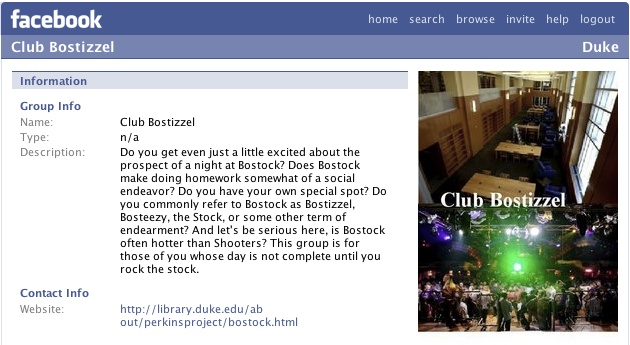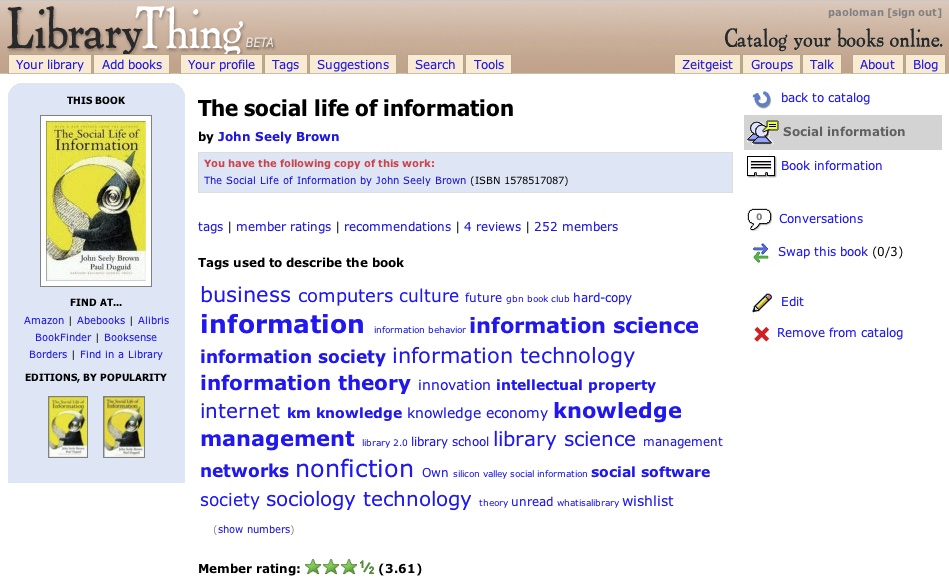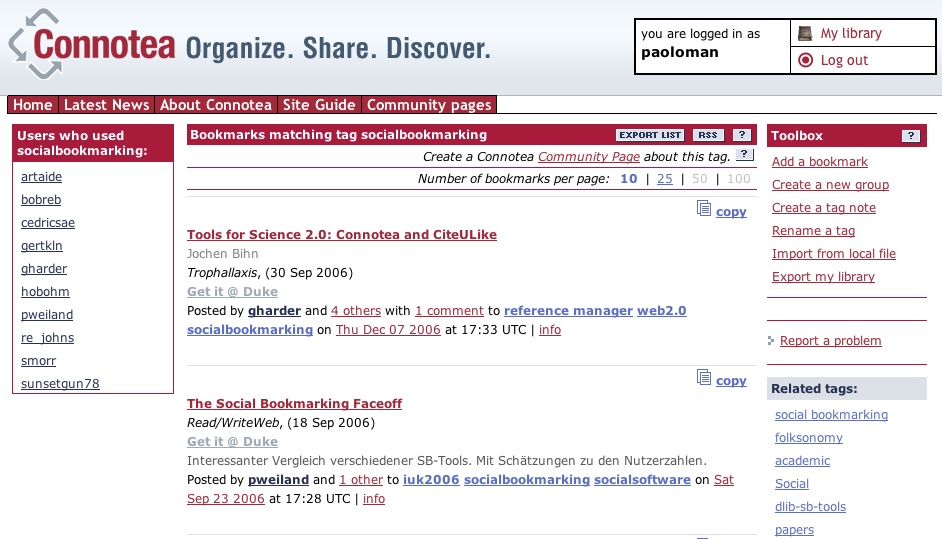by Paolo Mangiafico
 A few months ago I decided to see for myself what all the fuss was about, so I signed up for an account on Facebook (facebook.com), the social networking site used by almost every college student in the country. I joined the Duke community on Facebook and began to set up my profile. Curious to see if any of my library colleagues were already in Facebook and would consent to being one of my Facebook “friends,” I typed “Bostock” into the search box and was surprised to find seventeen groups at Duke matching the name of one of Duke’s new library buildings. Would you believe Bostock Groupies R Us (9 members)? How about Bostock Is Better Than Home (22 members)? Bostock Study Group, the Bostock Bunch, even Club Bostizzel and Club Bostock (117 members!). I even found a student-sponsored library sleepover event called Bedstock (“because it’s not like we don’t spend enough time in the library,” 11 participants).
A few months ago I decided to see for myself what all the fuss was about, so I signed up for an account on Facebook (facebook.com), the social networking site used by almost every college student in the country. I joined the Duke community on Facebook and began to set up my profile. Curious to see if any of my library colleagues were already in Facebook and would consent to being one of my Facebook “friends,” I typed “Bostock” into the search box and was surprised to find seventeen groups at Duke matching the name of one of Duke’s new library buildings. Would you believe Bostock Groupies R Us (9 members)? How about Bostock Is Better Than Home (22 members)? Bostock Study Group, the Bostock Bunch, even Club Bostizzel and Club Bostock (117 members!). I even found a student-sponsored library sleepover event called Bedstock (“because it’s not like we don’t spend enough time in the library,” 11 participants).
Club Bostock’s introductory page reads:
Honestly, it was only a matter of time. This is formal recognition of the resurgence that has taken place in studying interest. The opening of Bostock has either improved your grades or improved manners in which you can procrastinate. Club Bostock, your friendly campus club that has no cover charge, open later than the other spots, and you don’t have to worry about no damn A.L.E. [Alcohol Law Enforcement]
If you answer “yes” to the following questions, then you are probably a frequent clubber at Club Bostock.
1. Do you find yourself borderline excited to go to Bostock?
2. Can you run into half of your friends walking through the lobby?
3. Have you ever spent more time socializing then actually studying?
4. Can you spot finer females/males at Club Bostock than Club 9?
5. Have you had an evening where you don’t even have that much work to do, but you find some assignment worthy of a trip to Bostock?
If some of these questions have struck a cord [sic] with you, then you are clearly one who frequents Club Bostock.
The library has suddenly become cool? What’s going on here?
 Bostock’s popularity among students indicates that the vision we’ve had in designing and renovating our library buildings—more inviting spaces for connecting people with people as well as connecting people and ideas — has been realized. OK, so maybe these Facebook groups are not exactly focused on academic pursuits, but amid all this socializing there must be some studying going on and some conversations and collaborations that are conducive to better scholarship.
Bostock’s popularity among students indicates that the vision we’ve had in designing and renovating our library buildings—more inviting spaces for connecting people with people as well as connecting people and ideas — has been realized. OK, so maybe these Facebook groups are not exactly focused on academic pursuits, but amid all this socializing there must be some studying going on and some conversations and collaborations that are conducive to better scholarship.
A few years ago the former head of Xerox PARC (Palo Alto Research Center — the research and development arm of Xerox) and a colleague wrote a book called The Social Life of Information, in which they examined the importance of social networks between individuals and groups for the creation and effective use of knowledge. One of the anecdotes they include in the book is about a study of Xerox copier repair staff and how they learned and shared information about how best to do their work. An anthropologist, Julian Orr, followed the copier repair representatives around and noted patterns in their behavior. Most of the time these reps were working on their own at customer sites.
Yet Orr found that the reps were remarkably social, getting together on their own time for breakfast, lunch, coffee, or at the end of the day — sometimes for all of the above. This sociability wasn’t simply a retreat from the loneliness of an isolating job. At these meetings, while eating, playing cribbage, and engaging in what might seem like idle gossip, the reps talked work, and talked it continuously. They posed questions, raised problems, offered solutions, constructed answers, and discussed changes in their work, the machines, or customer relations. In this way, both directly and indirectly, they kept one another up to date with what they knew, what they learned, and what they did. [ 1 ]
It turned out that the social networks connecting these workers were an effective way for them to learn and improve themselves and each other and were satisfying and fun for them, too. Xerox had provided these workers with plenty of training and documentation and gave them procedures for using these resources when they were working by themselves away from the office. Yet Orr’s findings contradicted Xerox’s assumptions of how workers would acquire and use information most efficiently:
Time spent together would, from the process perspective, be non-value adding. … But, as Orr showed, the reps … were critical resources for each other. The informal and extracurricular group helped each member to reach beyond the limits of an individual’s knowledge and of the process documentation.[ 2 ]
Eventually, Xerox gave a two-way radio to each of its field workers so they could confer with their peers quickly and easily. The company also set up a database called Eureka, where the reps could write up tips they wanted to share with their colleagues and comment on tips posted by others. Through a rating and review system, tips deemed to be most useful rose to the top, and the people who submitted them built social capital and recognition among their peers, reinforcing a process that was both productive and socially rewarding.
 Xerox was ahead of its time. In the past few years almost every successful dot-com Web service has added social aspects to its information services. It’s been called Web 2.0 or the social web, and many online services now say they’re building an “architecture of participation.” While continuing to focus on satisfying the needs and motivations of individual users, these services also use individual contributions to build a communally-beneficial and socially-rewarding experience. The growing importance of this model led Time Magazine to declare in 2006 that the users of these systems — and the communities built around them — were the “person of the year.”
Xerox was ahead of its time. In the past few years almost every successful dot-com Web service has added social aspects to its information services. It’s been called Web 2.0 or the social web, and many online services now say they’re building an “architecture of participation.” While continuing to focus on satisfying the needs and motivations of individual users, these services also use individual contributions to build a communally-beneficial and socially-rewarding experience. The growing importance of this model led Time Magazine to declare in 2006 that the users of these systems — and the communities built around them — were the “person of the year.”
Let’s put aside for a moment sites like Facebook and MySpace, which are primarily social spaces, and look at sites like Amazon, Wikipedia, or my current favorite, LibraryThing. In each of these, the main focus of the site is not social networking or entertainment. For Amazon (amazon.com), it’s selling books and other merchandise; for Wikipedia (wikipedia.org), it’s sharing information on almost any topic imaginable; for LibraryThing (librarything.com), it’s keeping track of books you’ve read or want to read.
Yet underlying each of these services is a culture and set of functionality that encourages participation and fosters a sense of community. At Amazon, you can post reviews, create lists, engage in discussions, or just read what other users of the site have posted. Wikipedia, on its surface, is an encyclopedia, but underneath is a huge community bubbling with discussion and debate, where issues are getting hashed out and ideas and texts are being refined. At LibraryThing, you can organize your personal library, read or write reviews, find out about books liked or disliked by those who share your tastes, and even swap books when you’ve finished reading them.
 At the Duke Libraries, we’re starting to experiment with some services like this, too. In spring 2007 we’re conducting a pilot of Connotea (connotea.org), a “social bookmarking” tool similar to the popular del.icio.us service, but designed for academics. To use it, you sign up for an account to create your personal “library” of citations in the system and add a Connotea button to your Web browser. Then, when you find something on the Web you want to keep track of for future reference (a journal article, catalog record, or any web page), you click the button to add the citation to your Connotea library.
At the Duke Libraries, we’re starting to experiment with some services like this, too. In spring 2007 we’re conducting a pilot of Connotea (connotea.org), a “social bookmarking” tool similar to the popular del.icio.us service, but designed for academics. To use it, you sign up for an account to create your personal “library” of citations in the system and add a Connotea button to your Web browser. Then, when you find something on the Web you want to keep track of for future reference (a journal article, catalog record, or any web page), you click the button to add the citation to your Connotea library.
The system will pull in whatever information about the reference it can (for journal articles, for example, it usually is able to pull in the title, author, journal issue and a few other fields of metadata) and then allow you to add your own description (both keyword “tags” and descriptive prose, if you’d like) and comments on the resource. You can choose to keep your citations private and use them just to aid your own ability to find the resources again later, or you can share them with other users of the system. If you do share (and most users do), Connotea can then identify patterns in the kinds of things being cited and how they are described and use these to recommend other items you might want to look at.
When you’re browsing citations others have entered, you can use a “copy” link to add a citation to your own citation library in one click and then add your own description or comments if you wish. You can sort your library of citations by descriptive terms, the date you entered them, alphabetically, and so on, and you can export the citations in standard formats and to citation management software like EndNote.
In collaboration with Duke’s Office of Information Technology, Arts & Sciences Information Science and Technology, and the Center for Instructional Technology, the library is also exploring other “social software” tools that might provide a platform for online collaborations between Duke students and faculty. One system currently in a pilot phase is called Elgg (elgg.net), which its developers describe as “social networking for education,” a kind of MySpace or Facebook for academic purposes.
 Faculty and students create accounts in the system and develop personal profiles in which they can describe themselves and their interests. They can add other users of the system as “friends” and create or join any number of groups (say, a project team for a course, a study group on a particular topic, or just a social group). In their personal or group spaces, users can set up blogs and discussion boards, deposit files to be shared (including multimedia files they want to podcast), and work on collaborative projects in these shared spaces. Any of the items in the system can be tagged with descriptive terms, and as with Connotea, Elgg will highlight similarly tagged items and lead readers in directions pointed out by their colleagues. Each user has a “dashboard” page where they can subscribe to syndicated feeds from any of their friends or shared groups (or external news sources or blogs) and be notified whenever there are updates.
Faculty and students create accounts in the system and develop personal profiles in which they can describe themselves and their interests. They can add other users of the system as “friends” and create or join any number of groups (say, a project team for a course, a study group on a particular topic, or just a social group). In their personal or group spaces, users can set up blogs and discussion boards, deposit files to be shared (including multimedia files they want to podcast), and work on collaborative projects in these shared spaces. Any of the items in the system can be tagged with descriptive terms, and as with Connotea, Elgg will highlight similarly tagged items and lead readers in directions pointed out by their colleagues. Each user has a “dashboard” page where they can subscribe to syndicated feeds from any of their friends or shared groups (or external news sources or blogs) and be notified whenever there are updates.
The library is also launching a number of blogs written by library staff. The blogs will create new avenues for sharing information with the Duke community about library services and academic resources and, perhaps more importantly, offer the community new ways to engage us in conversations. Readers will be able to subscribe to the blogs via e-mail or RSS (a standard protocol for syndication of news and blogs) or just to read them on the Web. Each page will have a comment forum that invites discussion or suggestions from library users.
And it’s not too hard to imagine a day soon when the library catalog itself might be more like Amazon or LibraryThing, a place where you could add your own annotations, descriptions, reviews, and ratings of library resources both for your own use and to be shared with others in the community. The catalog could offer recommendations of books you might want to read, based on reviews or reading patterns of other scholars in the field, or allow you to search inside the book or read excerpts from it before you head to the stacks to find it.
We hope these services and others like them will help Duke scholars find resources and work with each other in more efficient, interdisciplinary, and collaborative ways. And let’s not forget fun. The developer of LibraryThing recently wrote in his blog about the philosophy behind the site:
Why not be fun? The library itself is fun. … The catalog is a condensed representation of that fun. It’s not the books, but it has a lot to say about them, and it can be the springboard for so much more. I enjoy reading and thinking about books. I want to remember what I read, much as I want to remember my vacations. I want help finding new ones. I want to put my books out there for all to see. I want to express myself about them. I want to find people to talk about our books. I might even want to date someone who reads the same things I do.[ 3 ]
The Bostock Facebook groups and library buildings full of students are evidence that the libraries at Duke are successful spaces for social as well as solitary learning. We’re now hard at work making sure that the online services we provide are as effective at supporting research and collaboration — and as fun — as our physical library spaces are.
Paolo Mangiafico is a digital project consultant in the Digital Projects Department at the Duke University Libraries.
Notes
1. John Seely Brown and Paul Duguid, The Social Life of Information (Boston: Harvard Business School Press, 2000), 102.
3. Tim Spalding, Is your OPAC fun? (a manifesto of sorts)



One thought on “The Social Life of Libraries”
Comments are closed.